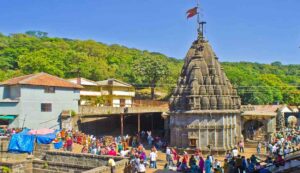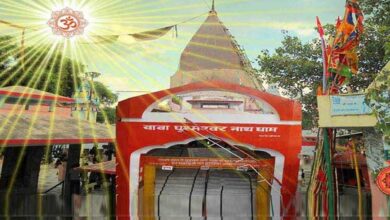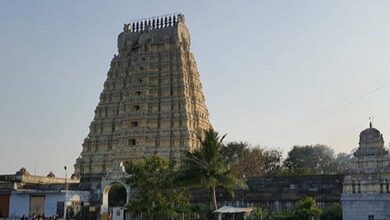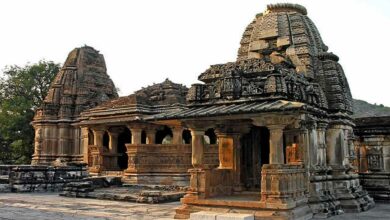Bhimashankar Temple: Know about the glory, importance and history of this Jyotirlinga located in Maharashtra
Bhimashankar Temple: One of the twelve Jyotirlingas on India’s sacred path is Bhimashankar Jyotirlinga. As the sixth Jyotirlinga, it is regarded as such. The unique residences of Lord Shiva, where he first manifested as a pillar of light, are known as the twelve Jyotirlingas. The temple of Lord Bhimashankar is surrounded by thick woods, lakes, rivers, and a variety of wildlife since it is situated on the Bhimashankar mountain, which is on the banks of the sacred Bhima River in the Ghat area of the Sahyadri Mountains. As a result, it is a captivating sight for the temple’s worshippers.

Significance of the Bhimashankar Temple
It is said that a swayambhu linga or a linga that spontaneously arose, served as the foundation for the old temple. As a result, this shrine has enormous value. In the temple’s sanctum sanctorum, the linga is situated squarely in the centre of the floor. The temple has intricate carvings of both human and heavenly figures on its entrance frames and pillars. Here, other scenes from mythology are also shown.
A shrine dedicated to Lord Shaniswara is also located inside the temple. A statue of Lord Shiva’s chariot, Nandi, is located at the temple’s entrance, as is typical in Shiva temples.
The Sahyadri mountain range’s thick woods are home to Bhimashankar Jyotirlinga. This location is very gorgeous due to the surrounding high mountains, verdant flora, and serene mood. One of Lord Shiva’s twelve Jyotirlingas is this one. This Shivlinga is Swayambhu, meaning it was created spontaneously. Bhimashankar Jyotirlinga is a significant historical, religious, and tourism destination. It is well-known across the globe for its serene ambiance, religious importance, and natural beauty.
One of the most revered Jyotirlingas is Bhimashankar Temple, which is situated in Maharashtra under the shadow of the Sahyadri Hills. Lord Shiva is the object of devotion at this historic temple. In keeping with Hindu mythology and spiritual devotion, it has a rich and engrossing past. The ancient tales of Lord Shiva’s heavenly appearances and battles with evil powers are its source.
Legend has it that Lord Shiva and the demon Tripurasura engaged in a bloody battle that gave birth to the Bhima River, also called Chandrabhaga. The temple’s name and hallowed site were inspired by this momentous occasion. Due to its centuries-long history, the temple draws visitors and devotees from all over the world who want to experience Lord Shiva’s heavenly presence.
Temple of Bhimashankar Jyotirlinga
Lord Shiva, the God of obstacles, is said to have manifested as a colourful pillar of light at twelve distinct locations around India, according to the traditions of Shiva Mahapuran. These locations are revered as holy pilgrimage places and are referred to as Jyotirlingas. The Bhimashankar Jyotirlinga Temple in Maharashtra is home to one such Jyotirlingam, which is still a significant holy site for followers. In addition to its religious importance, this architectural wonder is encircled by luxuriant flora. The Bhima River’s banks are where the temple is situated.
Devotees have a particular place in their hearts for the Bhimashankar Jyotirlingas, the holy shrines of Lord Shiva, since it is said that Lord Shiva personally visited them. In India, there are twelve of them. The meaning of Jyotirlinga is “pillar or pillar of light”. There is no beginning or finish, as the “pillar” symbol indicates. Lord Shiva showed up as a pillar of light and urged Lord Brahma and Lord Vishnu to find the end of their argument about who was the ultimate deity. Neither was able to. Jyotirlingas are said to be positioned in the same locations where these pillars of light descended. Nestled among mountains, lakes, and thick woods with a diverse range of plants and animals, Bhimashankar Jyotirlinga is a well-liked location for pilgrims and environment lovers.
Bhimashankar Jyotirlinga’s location
The Maharashtra state’s Pune district is home to the Bhimashankar Temple. The temple is located around 110 kilometres from Pune in the Sahyadri mountain range. The temple is situated close to the Bhima River’s source, which is a significant tributary of the Krishna River.
History of Bhimashankar
The legends surrounding the building of the Bhimashankar Temple stretch all the way back to the period when the gods lived on earth. A demon called Bheem, the son of Ravana’s brother, the demon king Kumbhkarna, dwelt in the jungle around Bhimashankar. He learnt that Lord Rama, a manifestation of Lord Vishnu, had murdered his father while he was lost in the wilderness. This infuriated Bhima, who then resolved to get retribution.
To please Lord Brahma, he began to meditate and engaged in intense penance for a number of years. Lord Brahma granted his request to become the most powerful after seeing his commitment. By defeating Lord Indra and other gods, he began to wreak havoc. He then vanquished Karpureswara, also known as King Priyadharman, who was a devoted follower of Lord Shiva. After being imprisoned, the monarch began to worship Lord Shiva as Shivalinga.
When Bhima saw this, he came in to strike the Linga with a sword. Lord Shiva emerged from the Linga before he could strike, and they engaged in combat. Bhima was reduced to ashes by Lord Shiva. The Bhimashankar Temple now stands in all its majesty and splendour among the Himalayas, where all the gods asked Lord Shiva to remain.
In order to appease Lord Shiva and request the boon of immortality, a demon by the name of Tripurasura is said to have undergone penance in the Bhimashankar forest. His dedication delighted Lord Shiva, who bestowed immortality upon him on the understanding that he would utilise his abilities to benefit the local populace. They were accepted by Tripurasura. But eventually, he lost sight of his pledge and began to annoy both people and gods. Lord Shiva prayed to his wife, Goddess Parvati, when the gods pleaded with him to take action to prevent the resulting chaos. After they both murdered Tripurasura and manifested as Ardhanari, there was universal peace.
Another mythology states that Bhima, an asura, dwelt in the Dakini woods in the Sahyadri mountain range with his mother, Karkati. In reality, he was the son of King Ravana’s younger brother, Kumbhakarna. He felt enraged upon seeing that Lord Vishnu had slain his father by taking on the form of Rama. To appease Lord Brahma, he committed extreme penance and promised to get retribution.
Brahma gave him great power in exchange, which he exploited to terrorise the world. In order to get Kamarupeshwara, a devoted follower of Lord Shiva, to worship him rather than Lord Shiva, he imprisoned him. Bhima raised his sword and destroyed the Shivalinga when Kamarupeshwara refused to comply. Then he was burnt to ashes by Lord Shiva, who materialised before him. According to popular belief, the Shivalinga presently stands where Lord Shiva first appeared.
Katha Bhimashankar Jyotirlinga
The Hindu mythical literature contains a number of legends related to the temple of Bhimashankar. One such tale states that during the Treta Yuga, Kumbhakaran, the brother of the wicked king Ravana in the Ramayana, had a son called Bhima who desired revenge for Lord Rama’s killing of his father.
Motivated by a desire for revenge, Bhima began to worship the creator deity Brahma by undergoing penance, and he bestowed upon him a great deal of strength. After becoming so powerful, Bhima became even more conceited and warned Kamarupeshwara, the monarch at the time, to cease worshipping Lord Shiva.
Bhima put the king in jail when he refused, but the monarch still worshipped and built a Shivalinga there. Blinded by the strength, Bhima attempted to use his sword to smash the Shivalinga, but Lord Shiva showed up and killed him to rescue the monarch, who was blameless. It is called Bhimashankar Jyotirlinga. After that, all the gods came there and asked Shiva to remain there as a Jyotirlinga.
Shivalinga Bhimashankar Jyotirlinga
One of the twelve Jyotirlingas is the linga of Lord Shiva. Unlike the lingas created by humans, these Jyotirlingas are self-manifested manifestations of Lord Shiva. Shiva is claimed to have manifested as a blazing pillar of light at the time of these Jyotirlingas. The Bhimashankar Linga is located below ground level in the main sanctum. A small groove in the linga separates the top of the linga. Lord Shiva and Goddess Parvati are represented by each side of the linga. In the temple of Bhimashankar, the Lord manifests as “Ardhanarishwar”. The Bhima River is revered by many because it is said to be the perspiration of Lord Shankar, also known as Shiva, after his victory over the demon Tripurasura.
It is said that Maharishi Kaushik, also called Brahmarishi Vishwamitra, undertook penance at Mokshakund, which lies behind the Bhimashankar temple, in order to appease the gods.
Hours of the Bhimashankar Temple
The temple is open from 4:30 a.m. until 9:30 p.m. The temple also conducts a number of ceremonies at this period. In addition to participating in darshan, devotees may participate in afternoon and evening aarti.
The official Bhimashankar Temple website
Bhimashankar Temple’s official website may be found at https://bhimashankar.in/. To get any kind of information on the Bhimashankar Temple Darshan Time Table, Puja, and Finance, you may use this website.
In brief
In addition to being a site of worship, Bhimashankar Temple is a great spot for those who value serenity and the natural world. We have the chance to experience spirituality, find calm in our lives, and connect with nature at this temple. Please browse our other articles and share this Bhimashankar Jyotirlinga post with your friends if you like it.
FAQs
Q: What is the location of Bhimashankar Temple?
A: This temple is situated in Maharashtra state’s Pune district, amid the Sahyadri mountain range.
Q: What role does Bhimashankar Temple play?
A: It is devoted to Lord Shiva and is one of the twelve Jyotirlingas.
Q: What is the Bhimashankar Temple’s history?
A: It is thought that the temple dates back to the eighth century.
Q: How does the Bhimashankar Temple’s architecture look?
A: The architecture of this temple, which was constructed in the Nagar style, is stunning.
Q: How can I go to the Temple of Bhimashankar?
A: From Pune, the temple is accessible via bus or cab.





